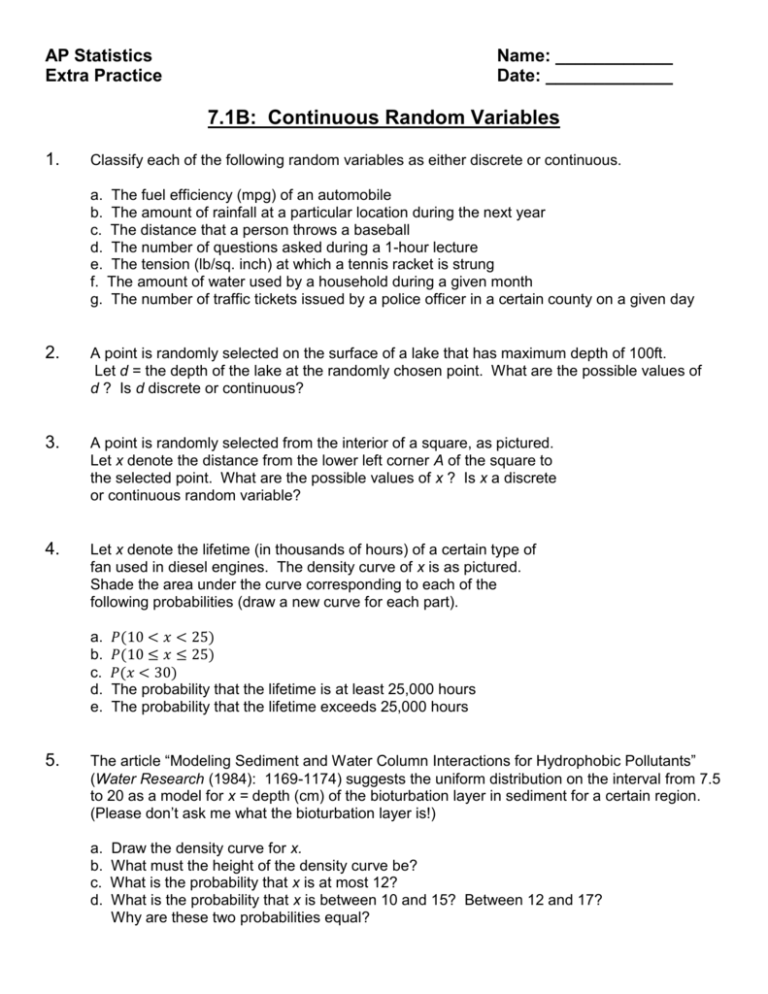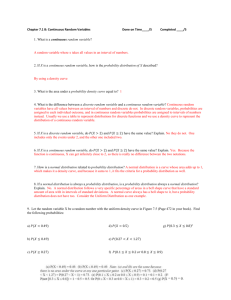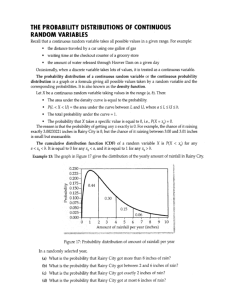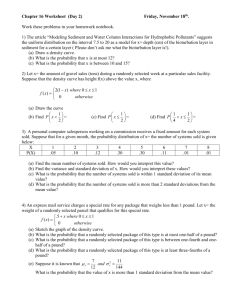AP Statistics: Continuous Random Variables Practice
advertisement

AP Statistics
Extra Practice
Name: ____________
Date: _____________
7.1B: Continuous Random Variables
1.
Classify each of the following random variables as either discrete or continuous.
a. The fuel efficiency (mpg) of an automobile
b. The amount of rainfall at a particular location during the next year
c. The distance that a person throws a baseball
d. The number of questions asked during a 1-hour lecture
e. The tension (lb/sq. inch) at which a tennis racket is strung
f. The amount of water used by a household during a given month
g. The number of traffic tickets issued by a police officer in a certain county on a given day
2.
A point is randomly selected on the surface of a lake that has maximum depth of 100ft.
Let d = the depth of the lake at the randomly chosen point. What are the possible values of
d ? Is d discrete or continuous?
3.
A point is randomly selected from the interior of a square, as pictured.
Let x denote the distance from the lower left corner A of the square to
the selected point. What are the possible values of x ? Is x a discrete
or continuous random variable?
4.
Let x denote the lifetime (in thousands of hours) of a certain type of
fan used in diesel engines. The density curve of x is as pictured.
Shade the area under the curve corresponding to each of the
following probabilities (draw a new curve for each part).
a.
b.
c.
d.
e.
5.
𝑃(10 < 𝑥 < 25)
𝑃(10 ≤ 𝑥 ≤ 25)
𝑃(𝑥 < 30)
The probability that the lifetime is at least 25,000 hours
The probability that the lifetime exceeds 25,000 hours
The article “Modeling Sediment and Water Column Interactions for Hydrophobic Pollutants”
(Water Research (1984): 1169-1174) suggests the uniform distribution on the interval from 7.5
to 20 as a model for x = depth (cm) of the bioturbation layer in sediment for a certain region.
(Please don’t ask me what the bioturbation layer is!)
a.
b.
c.
d.
Draw the density curve for x.
What must the height of the density curve be?
What is the probability that x is at most 12?
What is the probability that x is between 10 and 15? Between 12 and 17?
Why are these two probabilities equal?
6.
Let x denote the amount of gravel sales (tons) during a randomly selected week at a particular
sales facility. Suppose that the density curve has height f(x) above the value, x, where:
𝑓(𝑥) = {
2(1 − 𝑥) 0 ≤ 𝑥 ≤ 1
0
𝑂𝑡ℎ𝑒𝑟𝑤𝑖𝑠𝑒
The density curve (the graph of f(x)) is shown in the figure.
Use the fact that the area of a triangle = ½(base)(height)
to calculate each of the following probabilities:
1
a. 𝑃 (𝑥 < 2)
1
b. 𝑃 (𝑥 ≤ 2)
1
c. 𝑃 (𝑥 < 4)
1
1
d. 𝑃 (4 < 𝑥 < 2)
e. The probability that sales exceed ½ ton
f. The probability that sales are at least ¼ ton
7.
Let x be the amount of time (min) that a particular San Francisco commuter must wait for a
BART train. Suppose that the density curve is as pictured (a uniform distribution).
a. What is the probability that x is less than 10 min?
More than 15 min?
b. What is the probability that x is between 7 and 12 min?
c. Find the value c for which 𝑃(𝑥 < 𝑐) = .9.
8.
Referring to Exercise #7, let x and y be waiting times on two independently selected days.
Define a new random variable w by w = x + y, the sum of the two waiting times. The set of
possible values for w is the interval from 0 to 40 (since both x and y can range from 0 to 20.)
It can be shown that the density curve of w is as pictured.
(It is called a triangular distribution for obvious reasons!)
a. Verify that the total area under the density curve is equal to 1.
b. What is the probability that w is less than 20? Less than 10? More than 30?
c. What is the probability that w is between 10 and 30?
[Hint: It might be easier first to find the probability that w is not between 10 and 30.]








